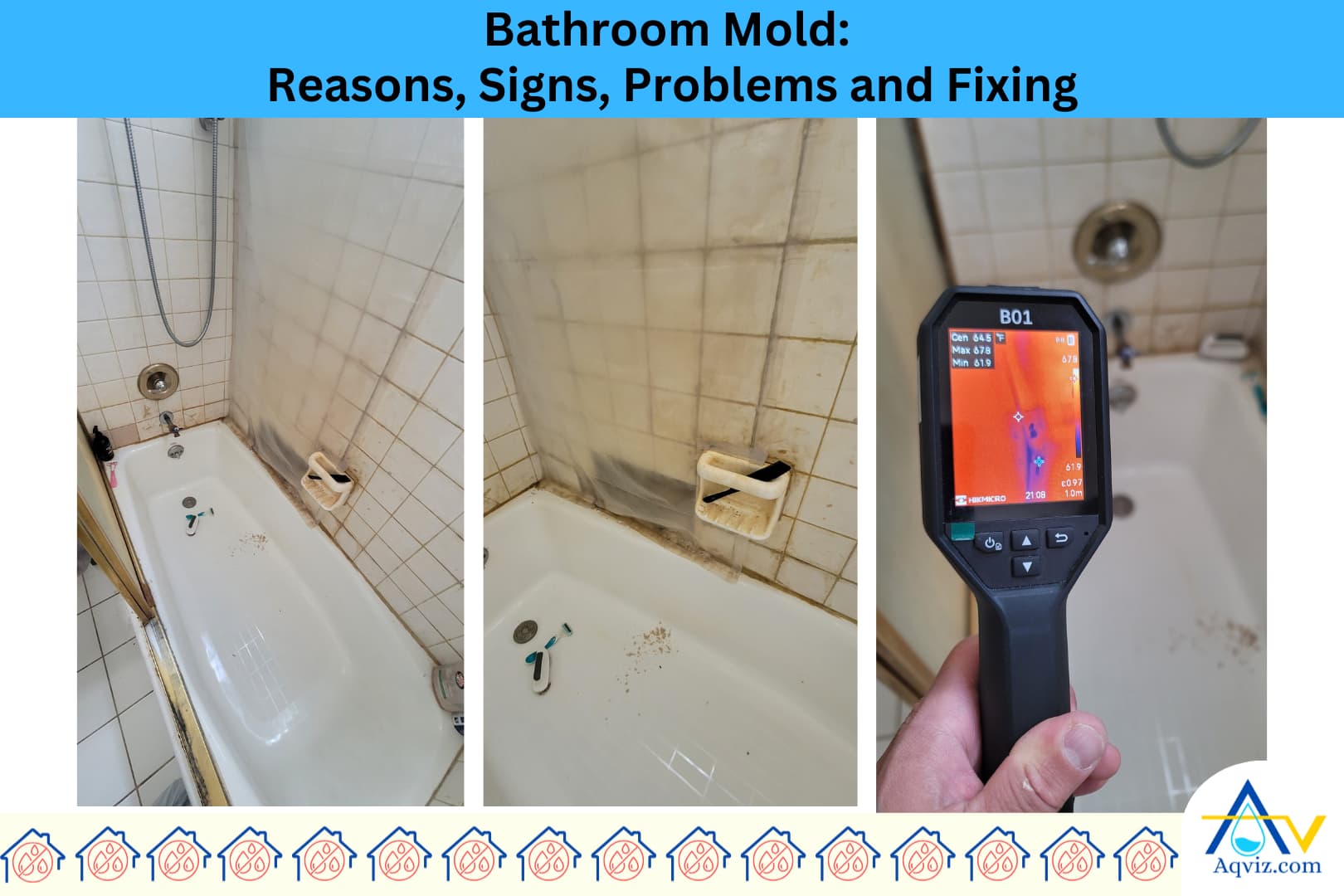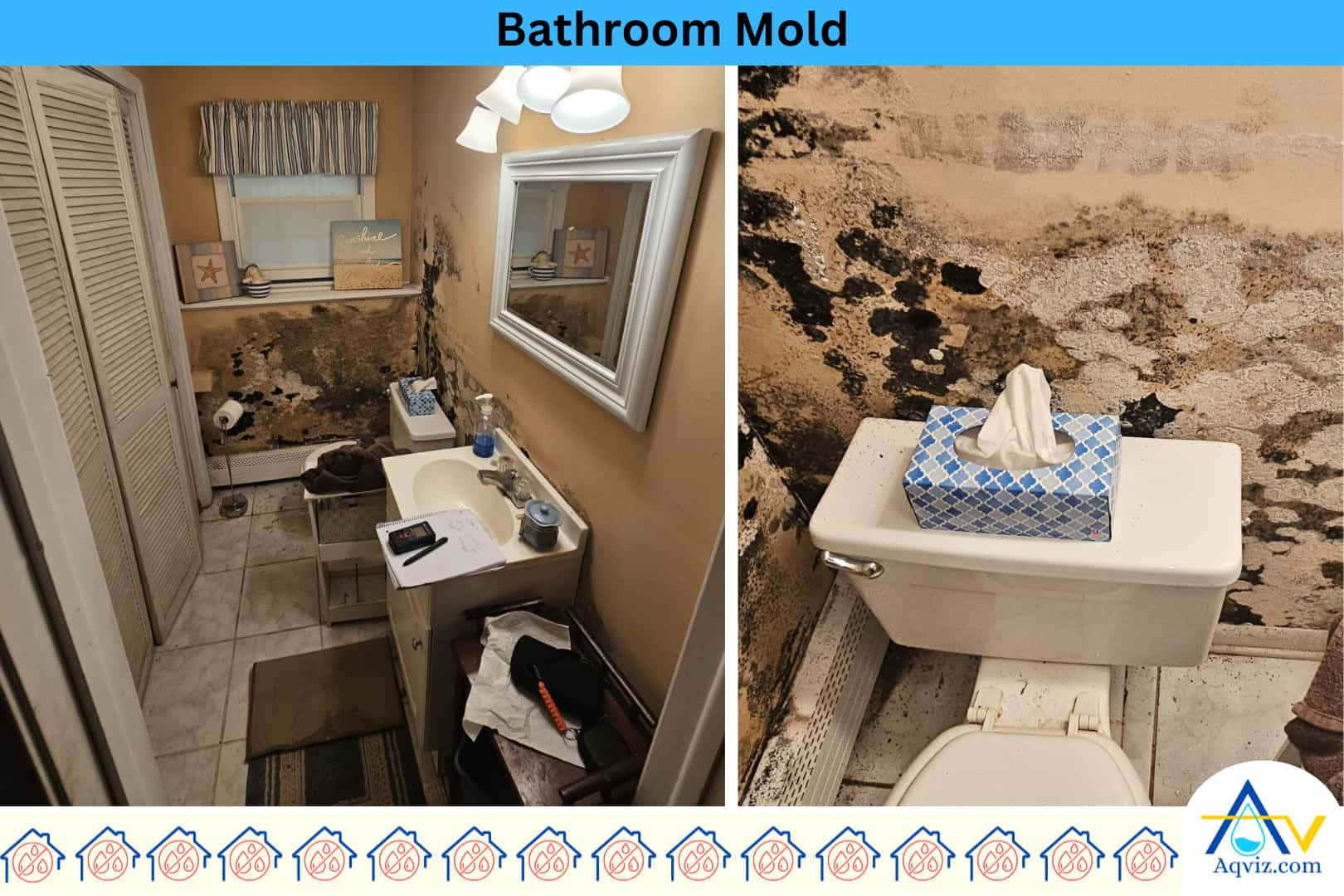Bathroom Mold: Reasons, Signs, Problems and How to Clean

Bathroom mold is a microbial fungus that grows on bathroom walls, floor, under the sink, ceiling, and vanity areas. Bathroom mold spreads due to organic materials, poor ventilation, lack of sunlight, and higher humidity in the bathroom.
Bathroom molds can be seen as black, green, white, and pink. Bathroom mold can be identified by the color, musty odor, discolored grout lines, peeling paint or bubbling walls, visible black spots, condensation on mirrors and windows, warped wood, or swollen cabinets in the bathroom.
Bathroom mold causes musty odor, discoloration of surfaces, health issues, surface deterioration, and reduced property value. To minimize mold impact in the bathroom, you should waterproof the bathroom, install a proper ventilation system, seal grout lines, and repair plumbing leaks.
When you see mold in the bathroom, you should clean it. Aqviz experts have prepared a mold cleaning process with including all tools, materials, and methods. So you should refer to the guide mentioned below and try to remove it DIY. Let us know if there is a problem. Aqviz experts will support you to fix this properly.

What is Bathroom Mold?
Bathroom mold is a microbial fungus that grows on bathroom walls, floor, under the sink, ceiling, and vanity areas. Bathroom mold spreads due to organic materials, poor ventilation, lack of sunlight, and higher humidity in the bathroom. Bathroom mold is mainly of 4 types in color, such as black, green, white, and pink.
Bathroom mold produces a stale and musty odor, and it triggers respiratory problems like asthma and allergies. And also, it spread on the organic materials by making visible stains on the surface. More than that, bathrooms cause serious water damage, such as peeling the paint, blistering, stains on the ceiling, and softening the gypsum boards in the bathroom.
To prevent this type of water damage, Aqviz experts highly recommend installing a bathroom waterproofing layer, including polyurethane liquid membranes, cementitious coatings, or sheet-applied HDPE barriers on the bathroom floor and walls. These waterproofing systems help to seal wet zones such as shower enclosures, bathtub surrounds, and underlayment floors by stopping water ingress and significantly reducing the risk of bathroom mold infestation.
What are the 4 Types of Mold in the Bathroom?
There are 4 main types of mold in the bathroom, including black mold, green mold, white mold, and pink mold.
- Black Mold (Stachybotrys chartarum) : Bathroom black molds are slimy and toxic. They usually grow behind walls, under tiles, and around leaky plumbing areas.
- Green Mold (Aspergillus) : Bathroom green molds are powdery and spread quickly on grout lines, ceilings, and shower walls.
- White Mold (Cladosporium) : Bathroom white molds are fluffy and often found in cold, damp areas like under sinks or toilet bases.
- Pink Mold (Serratia marcescens) : Bathroom pink molds are slimy and appear on shower curtains, tile corners, and soap trays due to soap and shampoo residue.
In Which Bathroom Areas are Mostly Affected by the Mold?
Bathroom areas like the wall, floor, ceiling, sink, and vanity are the most prone to mold growth due to the following reasons.
- Bathroom walls : Bathroom mold grows on the walls due to poor ventilation, high humidity from hot showers, water splashes, and internal pipe leaks behind the tiles.
- Bathroom floor : Bathroom mold forms on the floor because of standing water, cracked tiles, unsealed grout, and trapped moisture beneath the tile surface.
- Bathroom ceiling : Bathroom mold spreads across ceilings due to steam accumulation, lack of an exhaust fan, and condensation from warm air hitting cold surfaces.
- Inside the vanity : Bathroom mold grows inside vanities due to faucet leaks, damp cleaning supplies, and water pooling that gets trapped at the cabinet base.
- Under the sink : Bathroom mold appears under the sink from slow P-trap leaks, water dripping from supply lines, and poor airflow inside closed cabinets.
What are the Reasons for Mold in the Bathroom?
There are 6 major reasons for growing mold in the bathroom, including poor ventilation, plumbing leaks, unsealed grout and tile joints, condensation on cold surfaces, lack of waterproofing, and high indoor humidity.
- Lack of waterproofing: When there is no waterproofing system beneath tiles or around wet zones, gypsum boards, OSB, or screed are quickly saturated by the water. This constant moisture build-up creates hidden mold growing layers that stay damp despite surface cleaning.
- High indoor humidity: When there is higher humidity in the bathroom, it becomes more saturated with water vapor. It helps to grow mold and multiply quickly on the organic surfaces in the bathroom.
- Poor ventilation: Inadequate airflow from missing or underperforming exhaust fans prevents moist air from escaping the bathroom. As well as steam from showers and baths builds up on walls and ceilings, keeping surfaces wet and encouraging mold growth, especially in corners and along tile grout in the bathroom.
- Unsealed grout and tile joints: When grout lines are cracked, missing, or never sealed, water seeps through with every use. This trapped moisture behind wall and floor tiles creates a dark, humid environment for mold to thrive in the bathroom.
- Plumbing leaks: Slow leaks from flexible supply hoses, sink traps, or behind toilet connections release constant moisture into the bathroom. These damp areas provide ideal conditions for bathroom mold colonies to spread unnoticed.
- Condensation on cold surfaces: Warm bathroom air condenses on cold porcelain, glass, and metal fittings by leaving water droplets that never fully dry. So these wet surfaces become a repeated moisture source for mold to grow in the bathroom.
Read More About: All About Mold and Mildews: Signs, Causes, Impacts, Elimination
How to Identify Bathroom Mold?
Bathroom mold can be identified by these 6 clear signs, including musty odor, discoloured grout or tile joints, peeling paint, bubbling walls, visible black spots, condensation on mirrors and bathroom and warped wood or swollen cabinets.
- Musty odor : If you smell a persistent, earthy or musty scent, especially near shower corners or behind vanities, it is a strong signal of mold activity, even if no visible growth is present.
- Discolored grout or tile joints : When you observe black, green, or brown staining in grout lines, silicone joints, or wall corners, these discolorations are strong evidence of mold colonies growing where moisture is trapped behind the bathroom wall and floors.
- Peeling paint or bubbling walls : If you see paint cracking, blistering, or peeling on ceilings or tiled walls, it is a clear sign of trapped moisture behind the bathroom walls and floors, which supports hidden mold growth.
- Visible black spots or fuzzy patches : Occasionally, you may detect dark spots or fuzzy textures forming on caulking, ceiling tiles, or wallboard, it is direct and visible proof of fungal development due to poor ventilation or water ingress.
- Condensation on mirrors and windows : When you continuously observe fog or water droplets forming on glass surfaces, this ongoing humidity is a strong indicator of poor airflow and excessive moisture, which are ideal conditions for mold.
- Warped wood or swollen cabinets : If you feel soft, bowed, or raised surfaces on vanity wood panels or base cabinets, this physical damage is solid evidence that moisture is present, creating a breeding ground for mold beneath and behind.
What are the Problems Due to Bathroom Mold?
We have noticed there are 5 major problems due to bathroom mold, such as musty odor, discoloration of surfaces, health issues, surface deterioration, and reduced property value. The persistence of these problems affects human health and structural integrity heavily.
- Musty odor in the bathroom : Bathroom mold produces a musty, stale odor that lingers in the air. This odor is unpleasant and affects indoor air quality, making the bathroom feel damp and unhealthy.
- Discoloration of surfaces : Bathroom mold causes black, green, or brown stains on tiles, grout lines, and painted walls. These stains affect the aesthetic quality of the bathroom, making surfaces look dirty and poorly maintained.
- Health issues for occupants : Bathroom mold releases spores that trigger allergies, asthma attacks, and respiratory problems. This negative impact on human health can worsen over time, especially for children or elderly individuals.
- Surface deterioration : Bathroom mold penetrates grout, paint, and drywall, weakening their structure. This leads to peeling paint, crumbling plaster, and low-quality finishes in the bathroom.
- Reduced property value : Bathroom mold indicates poor maintenance and water-related issues, which can stop potential buyers from considering the property. This negative perception reduces the overall value and desirability of the home.

How to Minimize the Impact of Bathroom Mold?
To minimize the impact of bathroom mold, you should waterproof the bathroom and follow the 4 effective, consistent moisture control practices.
- Waterproof the bathroom : Bathroom waterproofing helps to prevent water from leaking into the substrate and stops seepage from walls and floors. It helps to keep surfaces dry and blocks mold and mildew from growing in wet zones like shower walls, behind tiles, and under basins.
- Install proper ventilation : A high-capacity exhaust fan removes humid air quickly after showers. This helps to decrease condensation on walls and ceilings, preventing the damp conditions that support mold growth in the bathroom.
- Seal grout and tile joints : Applying grout sealer and silicone caulk around joints stops moisture from penetrating porous materials. This sealing method helps to prevent hidden water intrusion and reduces the chance of mold forming behind bathroom tiles.
- Repair plumbing leaks promptly : Fixing leaking faucets, showerheads, or pipes in the bathroom helps to remove constant moisture sources. Quick repairs stop water from pooling under vanities or inside walls, which helps eliminate mold-supporting environments.
How to Clean Bathroom Mold?
To clean the bathroom mold, you should follow the 5-step guide below. Aqviz experts always follow these steps in all of our projects. These important steps help you to use the tools efficiently and complete the task with maximum effectiveness.
- Inspect and identify all affected areas: First, you should always start by using a bright LED inspection light and a moisture meter to detect mold spots behind tiles, under vanities, and along ceiling corners. This helps you to identify both visible and hidden mold growth in the bathroom caused by water leaks or poor ventilation.
- Wear protective gear before cleaning: Second, you should wear N95 respirators, rubber gloves, and safety goggles before starting mold mold-killing process in the bathroom. This step is critical to avoid inhaling mold spores or letting them come into contact with skin during cleaning.
- Scrub mold from hard surfaces using cleaning solution: You should use a mixture of 1 part bleach to 3 parts water or a commercial mold-killing cleaner like Concrobium Mold Control to clean the mold in the bathroom. As well as you can also use a stiff-bristle scrub brush to scrub on affected tiles, grout lines, and painted walls.
- Rinse and dry the area thoroughly: After scrubbing, you should rinse the bathroom surface using clean warm water and dry it with a microfiber towel or air blower. Then remove the excess moisture in the bathroom using an exhaust fan.
- Apply mold-resistant sealer: To prevent future mold growth in the bathroom, you should apply a mold-resistant grout sealer and anti-fungal paint primer on cleaned surfaces. These coatings help block future moisture penetration and discourage mold spores from forming again.
Aqviz Experts have investigated all of the bathroom water damages and listed out the 8 most common water damage in the bathroom and prepared a complete guide for each water problem with including reasons, signs, problems, and how to fix it properly as an expert. So we highly recommend you to refer to all of these 8 bathroom problems.
- Bathroom Sink Drain Leak
- Bathroom Faucet Leak
- Hot Water Leak
- Toilet Leak
- Bathroom Sink P Trap Leak
- Bathtub Overflow
- Cracked Shower Tray
- Bathroom Broken Tiles
Can You Paint On The Bathroom Mold?
No, you should never paint on bathroom mold. Painting over mold only hides the stain but doesn’t solve the moisture problem or kill the mold. It will grow back through the paint and spread further on the surface. You should always remove the mold completely, clean the surface with a mold remover, let it dry, and then apply a mold-resistant primer before painting. This ensures the mold doesn’t return and the paint lasts longer.
Is Bathroom Waterproofing Stop Mold Growth?
Yes, bathroom waterproofing helps stop mold growth effectively. You should apply cementitious or liquid waterproofing membranes beneath tiles, around wet zones, and behind walls to block water from reaching absorbent materials like gypsum boards, cement backer, and wooden subfloor.
What Will Increase the Mold Growth in the Bathroom?
Bathroom mold growth can be increased by the following 5 factors
- Poor ventilation in the bathroom
- Leak pipes and faucets in the bathroom
- Standing water on the bathroom surface
- Unsealed bathroom grout and cracked tiles
- Higher bathroom humidity
